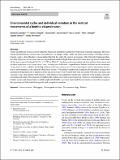Environmental cycles and individual variation in the vertical movements of a benthic elasmobranch
Abstract
Trends in depth and vertical activity reflect the behaviour, habitat use and habitat preferences of marine organisms. However, among elasmobranchs, research has focused heavily on pelagic sharks, while the vertical movements of benthic elasmobranchs, such as skate (Rajidae), remain understudied. In this study, the vertical movements of the Critically Endangered flapper skate (Dipturus intermedius) were investigated using archival depth data collected at 2 min intervals from 21 individuals off the west coast of Scotland (56.5°N, −5.5°W) in 2016–17. Depth records comprised nearly four million observations and included eight time series longer than 1 year, forming one of the most comprehensive datasets collected on the movement of any skate to date. Additive modelling and functional data analysis were used to investigate vertical movements in relation to environmental cycles and individual characteristics. Vertical movements were dominated by individual variation but included prolonged periods of limited activity and more extensive movements that were associated with tidal, diel, lunar and seasonal cycles. Diel patterns were strongest, with irregular but frequent movements into shallower water at night, especially in autumn and winter. This research strengthens the evidence for vertical movements in relation to environmental cycles in benthic species and demonstrates a widely applicable flexible regression framework for movement research that recognises the importance of both individual-specific and group-level variation.
Citation
Lavender , E , Alenynik , D , Dodd , J , Illian , J , James , M , Wright , P J , Smout , S & Thorburn , J A 2021 , ' Environmental cycles and individual variation in the vertical movements of a benthic elasmobranch ' , Marine Biology , vol. 168 , no. 11 , 164 . https://doi.org/10.1007/s00227-021-03973-1
Publication
Marine Biology
Status
Peer reviewed
ISSN
0025-3162Type
Journal article
Description
This research was supported by a PhD Studentship at the University of St Andrews, jointly funded by NatureScot via the Marine Alliance for Science and Technology for Scotland (MASTS), and the Centre for Research into Ecological and Environmental Modelling. The data were collected as part of research funded by NatureScot (project 015960) and Marine Scotland (projects SP004 and SP02B0) and the Movement Ecology of Flapper Skate (MEFS) project funded by the same organisations. Additional funding was provided from MASTS, in the form of a Small Research Grant, and Shark Guardian. MASTS is funded by the Scottish Funding Council (grant reference HR09011) and contributing institutions.Collections
Items in the St Andrews Research Repository are protected by copyright, with all rights reserved, unless otherwise indicated.

